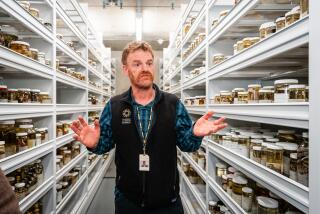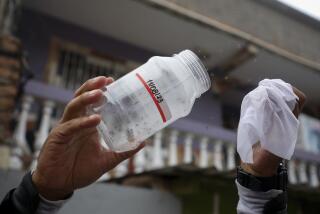The Hope of a Vaccine
In a room in a Seattle office building, behind what seems like enough safeguards to protect the occupants of a nuclear submarine, anopheles mosquitoes dine on Special K and the occasional malaria-infected mouse.
Researcher Stefan Kappe of the Seattle Biomedical Research Institute is harvesting parasites from their salivary glands in a quest to create something new: a malaria vaccine. He is getting tantalizingly close. By injecting mice with genetically modified parasites, he and his team have produced a colony of rodents that is immune to malaria.
If they can do the same for humans, it could mean the end of one of the deadliest plagues mankind has ever known. Or it could just be a waste of time, money and brainpower. We won’t know for at least a decade.
That’s the problem with drug and vaccine research: It’s very, very slow, and often even the most promising ideas hit dead ends. Time is the enemy for malaria victims. In Africa, a child dies of the disease, by the most modest estimates, every 30 seconds. In the years or decades it might take to produce a working vaccine, malaria will reap corpses by the millions -- 1 million to 3 million a year.
It’s possible to slash the time frame, and the deaths, if leading industrialized nations pay more attention. President Bush is expected to make an announcement about Washington’s commitment to the war on malaria as early as today. We can only hope he builds on the plan proposed by Gordon Brown, Britain’s chancellor of the exchequer, to give commercial biotechnology firms an incentive to create vaccines for diseases such as malaria and HIV. The plan was endorsed in principle this month by the finance ministers of the Group of 8, the club of wealthy nations whose leaders meet starting Wednesday in Gleneagles, Scotland. But that was the easy part; none of the G-8 members have yet been asked to put up any money to pay for it. The price tag will be in the billions -- yet it’s a bargain given both the humanitarian and economic benefits.
The Key to Prevention
There are a lot of weapons in the fight against malaria, all of which are either being misused or underfunded. Bed nets and insecticides go after the mosquitoes that spread the disease. A new generation of drugs targets the parasite after the victim is bitten and can even help stave off an infection. But you could blanket the continent with bed nets, blast whole villages with insecticide and deliver cheap drugs by the trainload without eradicating malaria in sub-Saharan Africa. Hot weather and unique breeds of malaria-carrying mosquitoes create a cycle of infection that is impossible to break. The only way to stamp out malaria in Africa is with an effective vaccine.
Scientists have come a long way toward producing one. Kappe isn’t the only researcher with a promising start. He’s in a friendly competition with a colleague at the SBRI, Patrick Duffy, who is testing a vaccine in Tanzania aimed at a vicious strain of malaria that attacks pregnant women and their unborn children.
Other important efforts are underway around the world. The one that provides the best hope for the near future is a compound now known mainly by the initials RTS,S (a recombinant protein that will get a catchier name if it ever becomes a marketable vaccine). The compound’s history gives a telling look into how market forces -- or rather the lack of those forces -- delay progress on a malaria vaccine.
Research on RTS,S was started almost two decades ago by London-based drug company GlaxoSmithKline. By the late 1990s, researchers had produced a vaccine that was protecting lab volunteers from malaria. But the program was slated to be cut in 1999 because Glaxo officials couldn’t see a viable market for it.
That’s precisely why few biotech companies make vaccines for Third World diseases such as malaria. The research commitment behind a new drug or vaccine is vast -- it can take from seven to 20 years to produce one, at a cost of up to $1 billion. Further, because many leads don’t pan out, drug companies take a risk every time they fund research into a new product. The only way to make the kind of profits sought by drug companies is to focus on ailments for which people with money are willing to pay a hefty premium.
Ninety percent of those who die of malaria live in sub-Saharan Africa, and most are children under 5. Their parents make on average less than $1 a day. That’s not a market that promises much of a return on investment for Big Pharma, which is why out of 1,233 drugs licensed worldwide between 1975 and 1997, just 13 were for tropical diseases -- and five of those were for veterinary purposes.
RTS,S research might have died in 1999 had not Glaxo sought outside grants to keep the work going. The Bill and Melinda Gates Foundation has since given $150 million to the Seattle-based Malaria Vaccine Initiative, which in turn funds the Glaxo project. The foundation also funds the research by Kappe and Duffy at the SBRI. (Full disclosure: The editor of these pages is married to the president of the Gates Foundation.)
Last fall, researchers published the results of a clinical trial of RTS,S in Mozambique, in which the compound was tested on children ages 1 to 4. The trial group saw a 30% reduction in clinical malaria attacks and a 58% drop in severe cases. Earlier this month, a second trial began looking at its effectiveness on infants. RTS,S has advanced further in clinical trials than any other malaria vaccine.
It would be nice if we could declare victory and move on. But RTS,S still has a lot of trials to go, and it could fail any one of them. And although a 30% reduction represents progress, it’s a long way from full or long-term immunity.
The Pull of Profits
The proposal endorsed by G-8 finance ministers aims to speed up vaccine research using a market-type concept that is catching fire in international aid circles: the “pull” program. So far, nearly all the research into malaria vaccines has resulted from “push” programs -- money is given to researchers in the form of grants. The money pushes the research forward. In a pull program, sponsors commit to a guaranteed payment to whomever can come up with an effective vaccine -- it “pulls” researchers in by creating the kind of commercial jackpot they could aspire to if they were working on a cure for a more “affluent” disease.
An independent committee would have to be set up to determine whether a new vaccine met the agreed-upon specifications. Sponsors would guarantee in advance to buy a huge quantity of vaccine at a set price, say $15 to $25 per person for the first 200 million people immunized. After that, the vaccine’s producer would have to drop the price substantially, to something like $1 or $1.50 a person, so that at least some African governments or citizens could pay for it themselves. By that time, the drug company would already have made a nice profit.
Sponsors pay only for success. If nobody comes up with a successful vaccine, sponsors don’t pay a dime. The drug companies take the risk, as they do in other endeavors in which they are chasing the rewards of a viable market. Pull programs provide an incentive for biotech firms, which employ armies of the best scientists in the world, to devote their resources toward the quest for a vaccine.
The Commitment Question
But to work, the pull model requires donors to commit big sums upfront; for a malaria vaccine, they would probably have to agree to pay about $4 billion. Some argue that money would be better spent on existing treatments such as bed nets and drugs. But donors can continue to spend whatever they want on those things until a vaccine is produced -- only in that year would they have to take money from other projects. And because a vaccine would be so much more effective than existing treatments, it’s well worth it.
Malaria isn’t the only disease for which advance purchase commitments are being studied, but it and HIV were identified by Britain’s Brown as the likeliest candidates. Brown has already pledged about $1.9 billion toward such a commitment. The G-8 finance ministers have asked Italian Finance Minister Domenico Siniscalco to come up with a concrete proposal for a vaccine program by the end of the year. After that, sponsors will have to decide if they’re willing to pay for it, and how much.
Passing up a cost-effective way to save the lives of millions of children wouldn’t just be immoral, it would be fiscally irresponsible. Malaria is a prime cause of global poverty, instability, overpopulation and misery. If the G-8 members cannot agree to kick in $4 billion to make this disease a thing of the past, the whole notion of multilateral development assistance will have proved a sham.
Bush has so far been reluctant to embrace Britain’s ambitious call for a Marshall Plan for Africa, but a commitment to fight malaria -- in tandem with America’s pledges to fight HIV/AIDS -- would show that the United States is not oblivious to the continent’s suffering.






